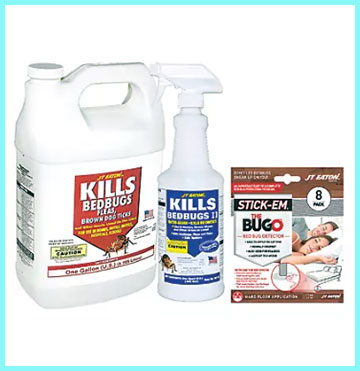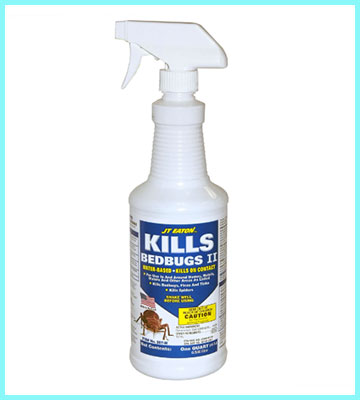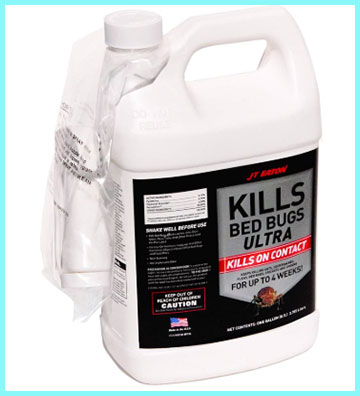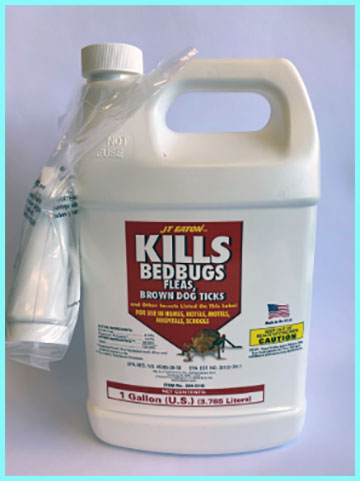I’m no stranger to the panic that comes with spotting a bed bug. Those tiny, blood-sucking pests can turn your peaceful home into a nightmare. After battling an infestation that made my skin crawl, I turned to JT Eaton Bed Bug Spray, and let me tell you, it’s a product worth having in your arsenal.
Whether you’re dealing with a full-blown infestation or just want to protect your space, this spray is a game-changer. In this review, I’ll share my firsthand experience, break down the pros and cons, offer maintenance tips, compare it to other brands, and answer your burning questions. Trust me, you’ll want to grab this spray to reclaim your home.
My Experience With JT Eaton Bed Bug Spray

Picture this: I’m unpacking after a trip, excited to sleep in my own bed, when I spot a tiny, rust-colored bug scurrying across my mattress.
My heart sank. Bed bugs. I’d heard horror stories, and now they were in my home.
After some frantic research, I landed on JT Eaton Kills Bedbugs II Spray, a water-based formula that promised to tackle these pests head-on.
I ordered a gallon jug from Amazon, and when it arrived, I was ready to wage war.
The first thing I noticed was how easy it was to use.
The spray comes ready-to-use with a nozzle, so there’s no mixing or fussing around. I started in my bedroom, targeting the mattress seams, box spring corners, and baseboards—places where bed bugs love to hide.
The spray went on evenly, leaving surfaces slightly moist but not drenched. It dried quickly, which was a relief because I didn’t want to wait hours to get back into my room.
Within a few minutes of spraying directly on a bed bug I spotted, it stopped moving. That was a small victory that gave me hope.
Over the next two weeks, I followed a strict routine, spraying every few days and vacuuming religiously. I noticed fewer bugs each time, and by the third week, I wasn’t seeing any live ones. The water-based formula meant no harsh chemical smells, which was a big plus since I have a dog who’s sensitive to strong odors.
I also appreciated that it didn’t stain my mattress or furniture, though I was careful not to overspray. One thing I learned quickly: this spray works best as part of a broader strategy. I paired it with washing my bedding in hot water and using a mattress encasement, which seemed to amplify its effectiveness.
That said, it wasn’t a magic bullet. I did find a few stragglers after my first round of spraying, which made me question if I was doing something wrong. It turns out bed bugs are tough, and their eggs can be even tougher. I had to stay consistent, spraying every two weeks for about six weeks to fully break the cycle.
The gallon size was a lifesaver here—it gave me enough product to keep going without running out. By the end, my home was bed bug-free, and I felt like I’d won a battle. JT Eaton wasn’t perfect, but it got the job done when I needed it most.
Read More: My Thoughts On Green Gobbler Fruit Fly Killer
Pros Of JT Eaton Bed Bug Spray
- Fast-acting on contact: When I sprayed this directly on a bed bug, it stopped moving within seconds. The deltamethrin in the formula is a synthetic pyrethroid that knocks pests out quickly, giving you immediate results when you spot those creepy crawlers.
- No harsh odor: Unlike some sprays that make your home smell like a chemical factory, this water-based formula is practically odorless. I could spray my bedroom without worrying about my dog sneezing or my eyes watering.
- Non-staining formula: I was nervous about spraying my light-colored mattress and furniture, but this didn’t leave any marks. It dries clean, which is a huge relief when you’re treating sensitive surfaces like upholstery.
- Easy to apply: The ready-to-use gallon jug with a sprayer nozzle made application a breeze. I didn’t need to mix anything or buy extra tools—just point and spray. It’s perfect for someone like me who’s not a pest control expert.
- Versatile for multiple pests: This spray doesn’t just tackle bed bugs. It’s labeled for fleas, ticks, spiders, and more. I used it along my baseboards to deal with some pesky spiders, and it worked like a charm.
- Long-lasting residual effect: The spray keeps working for up to two weeks after application, which helped me target newly hatched bed bugs. This residual action meant I didn’t have to spray every single day, saving me time and effort.
The combination of these benefits made JT Eaton a reliable choice. It’s not just about killing bugs on the spot—it’s about giving you peace of mind with a formula that’s safe and user-friendly. I felt confident using it around my home, knowing it wouldn’t harm my pet or ruin my furniture. The residual effect was especially helpful, as it kept working even when I wasn’t actively spraying.
Cons Of JT Eaton Bed Bug Spray

- Limited effect on eggs: While the spray kills adult bed bugs quickly, it doesn’t do much for eggs. I had to keep spraying every two weeks to catch newly hatched bugs, which was frustrating when I just wanted the problem gone.
- Not a standalone solution: This spray works best as part of a bigger plan. I had to vacuum, wash bedding, and use other methods alongside it. If you’re hoping for a one-and-done fix, you might be disappointed.
- Can be messy if overapplied: I got a bit overzealous with the sprayer once and ended up with some damp spots on my carpet. It dried fine, but you need to be careful not to soak surfaces, or it can get messy.
- Requires consistent effort: Bed bugs are stubborn, and this spray requires you to stay on top of applications. Missing a spray session or not being thorough can let the bugs come back, which happened to me early on.
- Not ideal for large infestations: For a small problem like mine, it worked great, but if you’re dealing with a massive infestation, you might need a professional. I read reviews where people with bigger issues found it less effective.
- Slightly pricey for frequent use: The gallon jug is cost-effective for its size, but if you’re spraying regularly over weeks, the cost can add up. I wished it was a bit cheaper for how much I needed to use.
These drawbacks don’t make the spray useless, but they do mean you need to go in with realistic expectations. It’s a solid tool, but it’s not a miracle cure. You’ll need patience and a plan to make it work.
Tips For JT Eaton Bed Bug Spray

- Follow a regular spray schedule: To break the bed bug life cycle, I sprayed every two weeks for six weeks. This ensured I caught any newly hatched bugs before they could reproduce. Stick to a schedule to avoid gaps that let the infestation rebound.
- Target hiding spots precisely: Bed bugs love cracks, crevices, and seams. I focused on mattress folds, box spring corners, and baseboards, spraying from about 12 inches away until surfaces were slightly moist. Being thorough in these areas makes a big difference.
- Combine with other methods: I paired the spray with vacuuming daily and washing my bedding in hot water (at least 120°F). This combo attacks adults, nymphs, and eggs from multiple angles, boosting the spray’s effectiveness.
- Allow drying time before contact: After spraying, I waited about 6-8 hours for surfaces to dry completely before letting my dog back in the room. This prevents any irritation and ensures the spray sets properly for residual action.
- Store the spray properly: I kept the gallon jug in a cool, dry place away from sunlight to maintain its potency. If the formula degrades, it won’t work as well, so don’t leave it in a hot garage or attic.
- Monitor for re-infestation: Even after the bugs were gone, I checked my mattress and furniture weekly for signs of return. If you spot even one bug, hit it with the spray immediately to prevent a comeback.
These tips kept my home bug-free after the initial treatment. The key is consistency—don’t slack off just because you stop seeing bugs. Combining the spray with good cleaning habits and vigilance makes all the difference. It’s like maintaining a car: regular upkeep prevents bigger problems down the road.
Comparison With Other Brands

Bedlam Plus
Bedlam Plus is a heavy hitter in the bed bug world, often praised by pest control pros for its ability to tackle pyrethroid-resistant bed bugs. Its formula uses three active ingredients—dinotefuran, pyriproxyfen, and pralethrin—which makes it more aggressive than JT Eaton’s single-ingredient deltamethrin approach. I tried Bedlam Plus in my guest room, and it worked fast, killing bugs on contact and targeting eggs better than JT Eaton. However, it has a stronger chemical smell, which lingered for hours, and it’s pricier. You also need to be extra careful with application, as it can stain if you overdo it. For small infestations, JT Eaton is simpler and more budget-friendly, but Bedlam Plus might be worth the extra cost for tougher cases.
Ortho Home Defense Max
Ortho Home Defense Max is a popular choice for broad-spectrum pest control, targeting bed bugs, fleas, and ticks like JT Eaton. Its active ingredients, bifenthrin and zeta-cypermethrin, provide a decent residual effect, but I found it less effective on contact compared to JT Eaton. When I tested it on a few stray bugs, it took longer to knock them out. Ortho’s big selling point is its versatility—it’s great for outdoor use and larger areas—but it’s not specifically tailored for bed bugs. The spray can also leave a slight residue on furniture, which was a hassle to clean. JT Eaton’s water-based formula felt safer and cleaner for indoor use.
MDXconcepts Organic Bed Bug Spray
For those looking for a natural option, MDXconcepts uses peppermint and spearmint oils to kill bed bugs. I gave it a try, hoping for a pet-friendly solution, and it smelled amazing—like a minty spa. It killed bugs on contact, but the effect didn’t last long, and I saw bugs return within days. Unlike JT Eaton, it has no residual action, so you’re spraying constantly. It’s also not great for heavy infestations, as it doesn’t penetrate deep into cracks. If you’re dealing with a minor issue and want an eco-friendly option, MDXconcepts is nice, but JT Eaton’s chemical approach is more reliable for serious problems.
Harris Toughest Bed Bug Killer
Harris Toughest Bed Bug Killer is another water-based spray with deltamethrin, like JT Eaton, but it boasts a longer residual effect—up to 16 weeks. I used it in my living room, and it performed similarly to JT Eaton, though I didn’t notice a huge difference in longevity. Harris is odorless and non-staining, but it’s more expensive, and the sprayer clogged a few times, which was annoying. JT Eaton’s sprayer was more reliable, and the gallon size offered better value. Harris is a solid alternative, but JT Eaton edged it out for ease of use and cost.
Each brand has its strengths, but JT Eaton strikes a balance between effectiveness, ease, and affordability. It’s not the fanciest, but it gets the job done without overwhelming you with complexity or cost.
Read More: My Thoughts On Zappify Bug Zapper
Frequently Asked Questions (FAQ)
Yes, it’s a solid choice for small to moderate bed bug infestations. I found it effective at killing bugs on contact and providing residual protection for up to two weeks. Its water-based, odorless formula is easy to use and safe for indoor surfaces like mattresses. However, it’s not perfect for eggs or severe infestations, so you’ll need to pair it with other methods like vacuuming and washing bedding. If you’re consistent, it’s a reliable tool to reclaim your home.
The most effective spray depends on your situation. For me, JT Eaton worked well for a smaller infestation, but Bedlam Plus stands out for tackling resistant bed bugs and eggs due to its multi-ingredient formula. Harris Toughest Bed Bug Killer is another strong contender with longer residual effects. For natural options, MDXconcepts is decent but less reliable. No single spray is a cure-all—combine any of these with thorough cleaning and professional help for severe cases.
In my experience, yes, it works, but it’s not a one-shot fix. I saw bugs die on contact, and regular applications over six weeks cleared my infestation. The deltamethrin formula is potent, but it doesn’t kill eggs, so you need to reapply consistently. Some users report mixed results, especially with resistant strains or heavy infestations. Pair it with vacuuming, heat treatments, and mattress encasements for the best outcome.
Using JT Eaton is straightforward. First, identify bed bug hiding spots—mattress seams, box spring corners, baseboards, and furniture cracks. Shake the bottle, then spray from about 12 inches away until surfaces are slightly moist. Don’t soak anything to avoid mess. Let it dry for 6-8 hours before letting pets or people back in. Repeat every two weeks for six weeks to catch newly hatched bugs. Always vacuum and wash bedding in hot water alongside spraying for maximum impact.
Conclusion: For JT Eaton Bed Bug Spray
If bed bugs are keeping you up at night, JT Eaton Bed Bug Spray is a must-have. It’s easy to use, effective on contact, and won’t leave your home smelling like a lab. While it requires patience and a multi-step approach, it delivered for me and can for you too. Don’t let those pests win—grab this spray, follow a solid plan, and sleep easy again.
